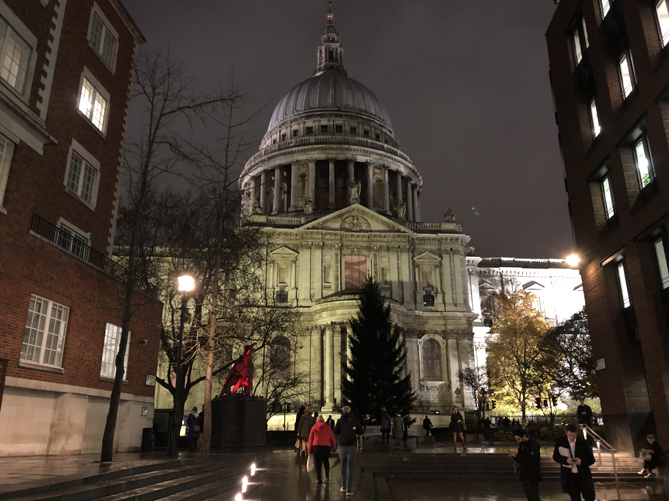Smartening London’s financial district, bit by bit
- December 2, 2019
- Steve Rogerson
I must admit, I found watching a guy standing in the middle of the street in the City of London using a mobile phone to dim and brighten the streetlights a little disconcerting. OK, I knew the guy was Alex Upton, one of the city’s electrical engineers, but I couldn’t help but thinking that this is just an app on a mobile phone.
What if someone else downloaded the same app and managed to get the log-in details? They could cause chaos. I was assured that the necessary security was in place to stop this, but I was unconvinced, especially when Giles Radford, highway manager for the city, admitted that nothing could be totally secure.
The occasion was a demonstration of the smart street lighting that is being installed in London’s famous square mile financial district, which includes the iconic St Paul’s Cathedral. One of the demonstrations was in Sermon Lane, overlooked by the cathedral (see picture). This little pedestrian area was once flooded with white light, but now with the technology the city authorities can adjust the lighting on the fly and create a more warm feeling.

A similar task may take place soon at the nearby St Martins Le Grand. This at the moment is open to cars and buses with pedestrian pavements down each side, and as such is brightly lit. But there is the possibility that in the next few years it could be completely pedestrianised. If that happens, the system will allow them to create another warm lighting area without installing new lights.
The streetlights are connected with a Wi-Sun mesh network using control technology from Itron. Lights on all the main and side roads have been connected and the footways and alleyways will be added early next year.
The move to LED lights themselves will bring at least 60 per cent energy savings and probably much more as they fine-tune the control to the best lighting levels, even on a light by light basis.
All good, but, and there is a but, Radford is now looking at ways this can be expanded to cover more smart city applications. They are looking at the usual suspects such as air quality monitoring, parking sensors and so on.
The problem is this is all a bit piecemeal. They can’t link in bin monitoring and collections – one of the standard smart city applications – because that is done by someone else. It can’t be connected to the existing city CCTV system, because the police run that. Any lighting control to, say, brighten an area if there has been an incident, would not be controlled by the city but by the police, once they sort out an access mechanism. The city’s wifi network is not linked in either. They don’t have, yet, monitors that will raise a street’s light levels if a pedestrian is detected.
What the engineers in the famous city are doing is good, but they would have been much better off planning a proper smart city network from the beginning rather than sticking in the smart lighting without sitting down with the police, the bin people, the wifi operators and other interested parties and planning a proper connected installation encompassing everything.
Hopefully, over time, they will sort all this out, and I am sure the will is there for them to do that, but wouldn’t it have been so much easier if they had done this from the start?





